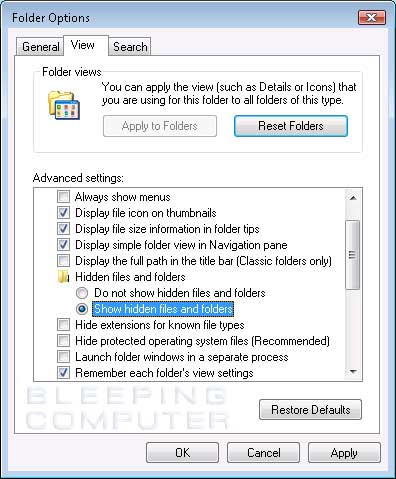Check Hidden Files Dos
Process To View All The Hidden Files And Folder using Command Prompt in Windows: Open Command Prompt (CMD.exe) as an Administrator. Navigate to the drive whose files are hidden and you want to recover. Type attrib -s -h -r /s /d. and hit Enter. Now you will get all the hidden files and folder as general files and you can use it. To apply this command follow the following steps. Go to Start Run type cmd. Dos will open type cd. (two to three time until only drive letter left) now type the drive letter in which you want to Unhide the files lets suppose in my case its F:. This will open the F: drive. Now type the following command attrib -r -a -s -h.
The attrib command is a Command Prompt command used to display or change the file attributes for a file or folder.
You can also find and set most file and folder attributes in Explorer. See the bottom of this page if you're interested in going that route versus using Command Prompt.
Attrib Command Availability


The attrib command is available in the Command Prompt in all Windows operating systems including Windows 10, Windows 8, Windows 7, Windows Vista, Windows XP, plus older versions of Windows as well.
All offline diagnostic and repair tools available with the various versions of Windows, including Advanced Startup Options, System Recovery Options, and Recovery Console, also include the attrib command in some capacity.
This attrib command is also available in MS-DOS as a DOS command.
The availability of certain attrib command switches and other attrib command syntax might differ from operating system to operating system.
Attrib Command Syntax & Switches
attrib [+a-a] [+h-h] [+i-i] [+r-r] [+s-s] [+v-v] [+x-x] [drive:][path][filename] [/s [/d] [/l]]
If you're not sure how to interpret the attrib command syntax you see above or shown in the table below, it's advised to learn how to read command syntax.
In Recovery Console, +c and -c switches are available for the attrib command, which set and clear the compressed file attribute, respectively. Outside of this diagnostic area in Windows XP, use the compact command to handle file compression from the command line.
When a wildcard is allowed with the attrib command, it means that you can use an asterisk (*) to apply the attribute to a group of files. However, if applicable, you have to clear the system or hidden attribute first before you can change any of the file's other attributes.
Show Hidden Files In Dos Virus
Attrib Command Examples
Show Hidden System Files Dos
In the above example, the attrib command is used to turn on the read-only attribute, using the +r option, for the secretfolder directory located in c:windowssystem.
In this example, the config.sys file located in the root directory of the c: drive has its hidden file attribute cleared by use of the -h option.
This time, the attrib command is used to remove multiple file attributes from the bcd file, an important file that must be working for Windows to start. In fact, executing the attrib command, as shown above, is a key part of the process outlined in the steps necessary for rebuilding the BCD in Windows.
With the above attrib command example, we're applying +a to set the archive attribute on all files that exist on the f: drive, but then using & to remove the archive attribute on every file on f: that has the .bakfile extension.
In the above example, BAK files indicate files that have already been backed up, meaning that they don't need to be archived/backed up again, hence the need to remove the archive attribute.
To end with a simple attrib example, this one simply displays the attributes of a file named myimage.jpg. If you were to remove the second half and execute only the attrib command, it would display the attributes for all files in the current directory.
Attrib Command Errors

Like with most commands in Command Prompt, remember to use double-quotes around a folder or file name that has spaces. If you forget to do this with the attrib command, you'll get a 'Parameter format not correct -' error.
Show Hidden Files Using Dos
For example, instead of typing my folder in Command Prompt to show the path to a folder by that name, you'd type 'my folder' to utilize the quotes.
Attrib command errors like 'Access Denied' mean that you don't have enough access to the file(s) you're trying to make attribute changes to. Take ownership of those files in Windows and then try again.
Changes in the Attrib Command
The +i, -i, and /l attrib command options were first available in Windows Vista and have been retained up through Windows 10.
The +v, -v, +x, and -x switches for the attrib command are only available in Windows 7, Windows 8, and Windows 10.
So after check out download, Install, play and Enjoy!Now Check Out Below Download link,download game and enjoy!According to me Download >>Install>>Play>>Enjoy!You can also Download PC Game. El matador torrent pc. Please see below screenshots and system requirements to understand you, Can you able to play this game on pc?
Attrib Related Commands
It's common for the xcopy command to effect a file's attribute after it backs up something. For example, the xcopy command's /m switch turns off the archive attribute after the file has been copied.
Similarly, the xcopy /k switch keeps a file's read-only attribute once it's been copied.
Viewing Attributes in Explorer
You can also view and manage attributes for files and folders in Explorer using regular menu buttons. This might be preferred for you if you're not familiar with the command line.
Do this by right-clicking the object and going into its Properties > General tab.